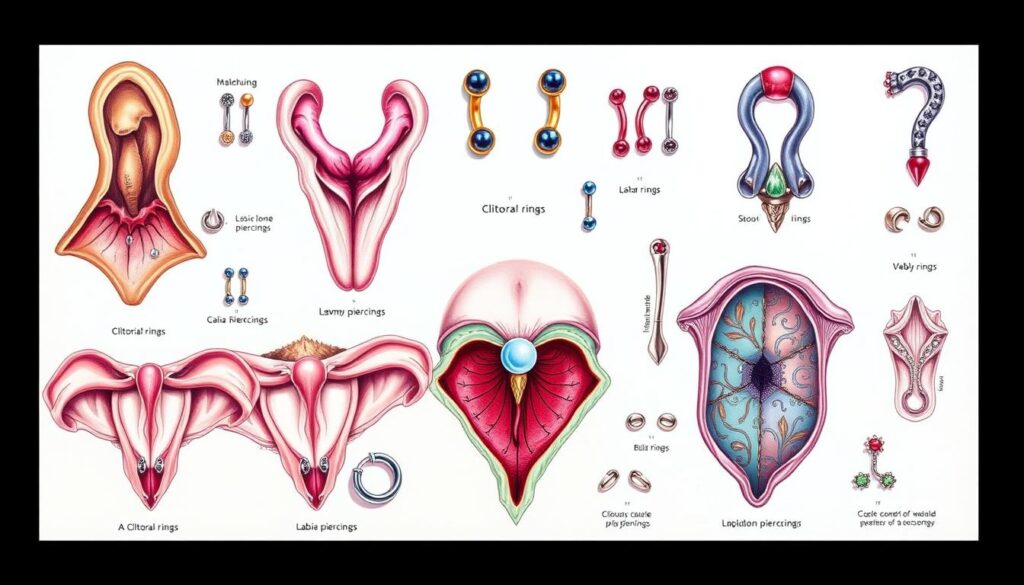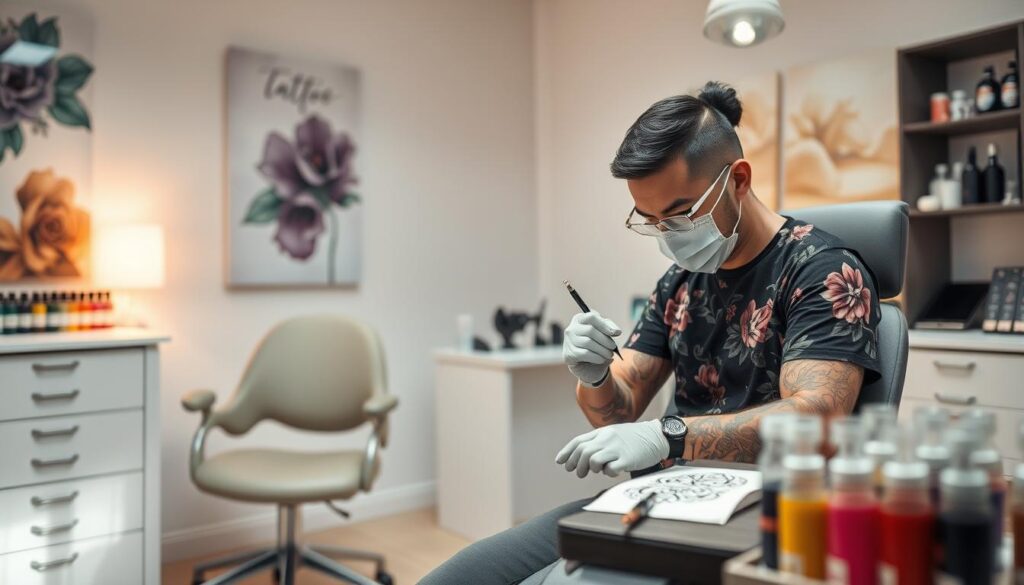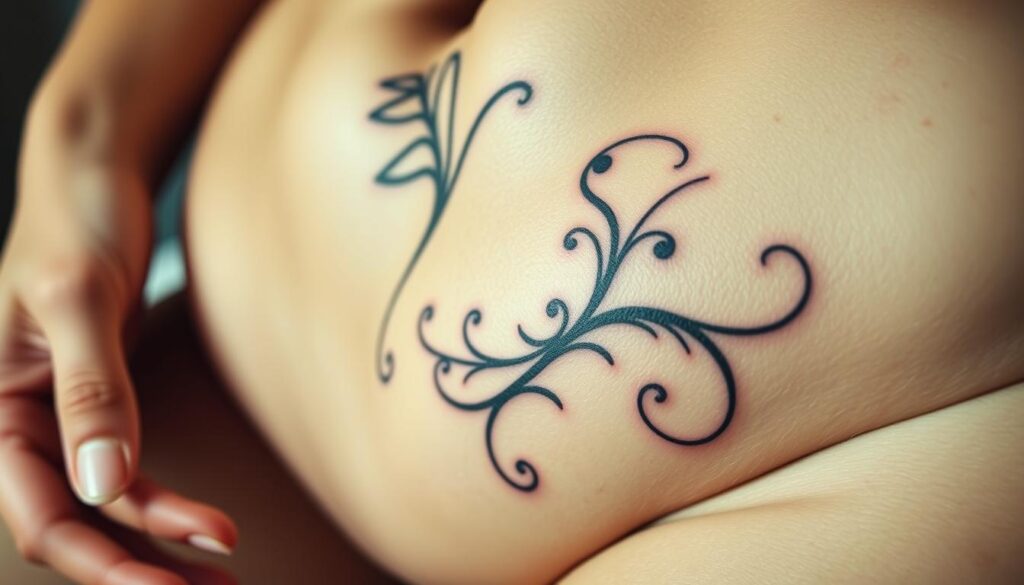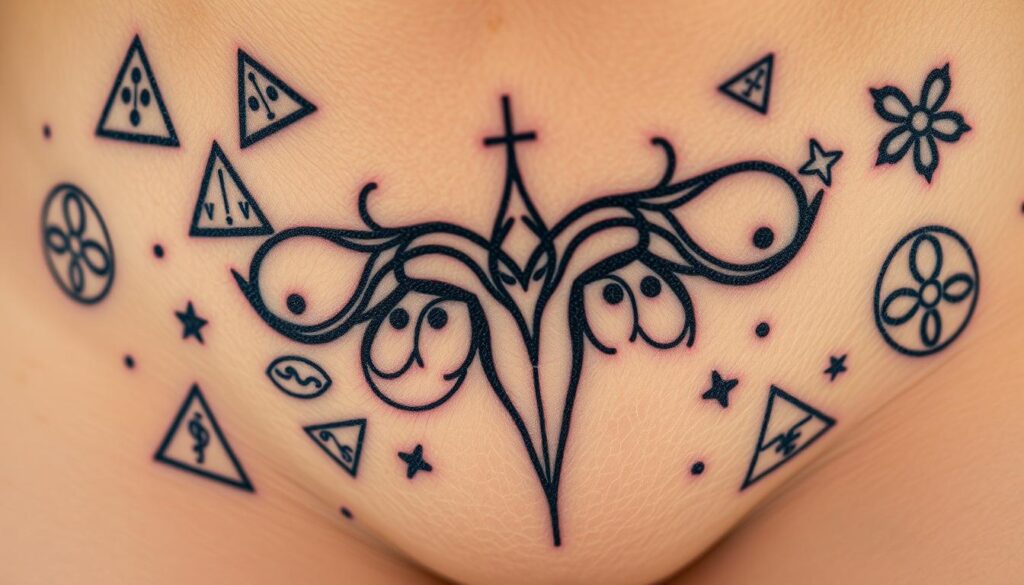Vaginal Tattoos: What You Need to Know
Have you ever thought about getting a vaginal tattoo? You might have seen beautiful intimate tattoos online or heard about people getting them as a way to express themselves. But, getting a tattoo in such a sensitive area can make you worry about safety, pain, and the process. This guide will help you understand vaginal tattoos, so you can decide if it’s right for you.
For some women, a vaginal tattoo is a powerful way to show self-love and take back control. It could be to hide scars, celebrate being a woman, or just to show who you are. Knowing what to expect, like the types of piercings and possible risks, is key. With the right information, you can choose a tattoo that truly reflects your values and goals.
Table of Contents
Understanding Vaginal Piercings
Vaginal piercings are becoming more popular as a form of body art. They can be placed on the clitoris, labia, or other parts of the vulva. These piercings can look great and even enhance sexual pleasure. But, it’s important to know about the different types and their special needs.
Types of Vaginal Piercings
Here are some common vaginal piercings:
- Vertical Clitoral Hood (VCH) Piercing
- Horizontal Clitoral Hood (HCH) Piercing
- Princess Diana Piercing
- Triangle Piercing
- Outer Labia Piercing
- Inner Labia Piercing
- Christina Piercing
- Fourchette Piercing
The Princess Albertina piercing is rare because it’s a complex procedure. The piercing you can get depends on your body’s shape. Not everyone can get all types of piercings.
“When performed by a professional in a clean, sterile environment, vaginal piercings are safe.”
Healing times vary for these piercings. Clitoral hood or Princess Albertina piercings can take 1-2 months to heal. Christina piercings might take 6-9 months or more. Good aftercare is key to avoid infections and help healing.

The Procedure: How Vaginal Tattoos are Done
Getting a vaginal tattoo is a unique and intimate experience. The intimate tattoo process involves several steps to ensure safety and comfort. First, the area is cleaned with an antiseptic solution to reduce infection risk.
The piercer then uses a hollow needle, usually 12- to 16-gauge, to carefully pass through the skin. This allows for the insertion of jewelry like barbells or rings. Clamps may be used to gently hold the labia in place during the vaginal tattoo procedure.
The procedure is generally quick, but discomfort levels vary. Some may feel a sharp sensation, while others might feel a dull, throbbing feeling.
“The healing process can take some time, but the end result can be a beautiful and empowering personal expression.”
It’s important to note that the number of tattoos received can range from 1 to 4. In some cases, a second set of tattoos may be needed if multiple areas are treated or if the treatment plan changes.

While getting a vaginal tattoo may be bold, it holds significant personal and cultural meaning for many. The healing process takes time, but the result can be a beautiful and empowering personal expression.
Pain and Discomfort
Getting a vaginal tattoo is a deeply personal experience. It’s important to know about the pain of vaginal tattoos and discomfort of intimate tattoos. The genital area is very sensitive because of many nerve endings and thin skin.
The genital tattoo pain levels vary from person to person. Pain tolerance is different for everyone. The tattoo needle can cause sharp pain as it pierces the skin. Yet, some people say the pain is not much worse than other tattoo spots.
“The pain was definitely intense, but I found it to be manageable with deep breathing and focusing on the end result. The discomfort was worth it for me to get the design I wanted in such a personal area.”
The pain and discomfort also depend on the tattoo’s size, location, and design. Bigger or more detailed tattoos can hurt more and take longer to heal. Talking to an experienced tattoo artist can help you know what to expect.

Choosing to get a vaginal tattoo is a personal decision. People should think about the pain of vaginal tattoos and discomfort of intimate tattoos against their desire for self-expression. Knowing the challenges helps you make a choice that fits your values and comfort level.
Risks and Complications
Getting a vaginal tattoo comes with risks. There’s a chance of infection, like tetanus or hepatitis. Other problems include pain, bleeding, and scarring.
There’s also a risk of skin infections and allergic reactions. Blood flow issues and tearing at the piercing site are possible. If the jewelry gets caught, it could affect condom use or pregnancy.
Potential Risks
Vaginal tattoos and intimate tattoos have many potential issues. Research shows 5 percent of people get infections from tattoos. A study found over a third of tattoo ink samples had bacteria.
- Allergic reactions to tattoo pigments, especially red ink, can cause swelling and skin tissue damage.
- Bacterial skin infections like staphylococcus are the most common tattoo-related infections.
- Serious infections like MRSA, while uncommon, are also possible if proper safety protocols are not followed.
- Viral infections like HIV or hepatitis may be transmitted through unclean tattoo equipment in rare cases.
- Infections may require weeks of antibiotics or even surgery in severe cases.
- Signs of infection include redness, swelling, pus-filled bumps, hotness, pain, fever, and itchiness.
- Allergic reactions can manifest as red, bumpy, itchy rashes that develop immediately or years later.
- Keloid scarring is a risk, especially for those prone to this condition.
- Tattoos can cause issues during MRI scans, leading to swelling or interference with imaging.
- Tattoo ink ingredients, particularly in black ink, have been linked to cancer, though more research is needed.
To avoid these risks, pick a reputable piercer. They should follow safety and sterilization rules. If problems happen, talk to a dermatologist about your genital tattoo.

Choosing the Right Piercer and Jewelry
Getting a vaginal tattoo? Finding a skilled vaginal tattoo piercer is key. Look for someone who’s part of the Association of Professional Piercers (APP). They should know how to keep things clean and safe.
Make sure the piercer cleans the area well, wears gloves, and uses a new needle. The right jewelry for intimate tattoos matters too. Choose materials like stainless steel, niobium, or titanium for better safety.
“Choosing the right piercer is the most important step in ensuring a safe and successful vaginal tattoo procedure.”
Check the piercer’s reputation and the studio’s cleanliness. A good piercer will answer your questions and help you through the process.
- Look for piercers who are members of the Association of Professional Piercers (APP)
- Ensure the studio is clean, well-lit, and uses sterile, single-use equipment
- Ask about the piercer’s experience with intimate tattoos and their aftercare recommendations

By picking the right vaginal tattoo piercer and the right jewelry for intimate tattoos, you’ll have a safe and successful tattoo experience.
vaginal tattoo Aftercare and Healing
Healing Process
Proper vaginal tattoo aftercare is key for your intimate tattoo to heal right. Your piercer will give you all the details. You should clean the area with a saline solution and soap and water every day. Then, dry it gently with a paper towel.
Avoid touching the piercing, having sex, or getting it wet for at least 2 weeks. Sometimes, it’s longer, depending on the piercing.
The healing process of genital tattoos varies. It can take 1-9 months, based on where it is. Clitoral hood piercings heal fast, while Christina piercings take longer.
During healing, you might see redness, soreness, and swelling. You might also notice a yellowish-white discharge, called “crusties.”
To care for your intimate tattoo properly, change your bedding often. Also, wear loose clothes over the area. Use an alcohol-free, unscented moisturizer to keep the tattoo looking great once it’s healed.
“Proper aftercare in the first few weeks after getting a tattoo can help prevent an infection and keep the tattoo looking good.”
If you see signs of infection, like extreme redness or pain, get help fast. Contact your piercer or a healthcare professional. Following the aftercare tips will help your vaginal tattoo heal well and safely.

Sexual Activity and Vaginal Tattoos
Intimate tattoos, like vaginal ones, can affect your sex life. Experts say to avoid sex for at least 2 weeks after getting a tattoo. This time is key to avoid problems and help the tattoo heal right.
Even after healing, be careful during sex. The tattoo or jewelry might damage condoms or diaphragms. Always use extra birth control with condoms if you have a piercing.
Talk to your partner about any changes in feeling or discomfort during sex. Being open helps you both enjoy your time together.
“The piercing may also cause discomfort or changes in sensation during sex, which should be communicated with your partner.”
Remember, sex and vaginal tattoos, or intimacy with genital piercings, need careful thought. Open talks, good aftercare, and safety measures help balance your tattoo or piercing with your sex life.
Cultural and Personal Significance
Vaginal tattoos can mean a lot to some people. In some cultures, getting tattoos or piercings in these areas is a big deal. It’s tied to important rituals and symbols.
In Fiji, for example, there’s a tradition called veiqia. It’s a way to decorate a woman’s body with tattoos. These tattoos tell stories of a woman’s life, from when she starts puberty to when she becomes a mother.
For others, getting tattoos in intimate areas is about feeling strong and positive about their bodies. It’s a way to take back control after something bad happens, like sexual abuse. These tattoos or piercings are like a badge of honor, showing a person’s courage and strength.
“The cultural meaning of vaginal tattoos and the personal reasons for intimate body art can be deeply significant, reflecting a person’s identity, experiences, and sense of self-expression.”
What these tattoos mean can vary a lot. People choose designs that mean something special to them. It could be an arrow for strength, a skull for the fleeting nature of life, or a flower for growth and getting through tough times.
In the end, deciding to get a tattoo in such a private area is a very personal choice. It can come from cultural traditions, personal feelings, or a mix of both.

Considering Vaginal Tattoos
Before getting a vaginal tattoo, it’s important to think it over carefully. This area is very sensitive and intimate. You need to understand the risks, discomfort, and long-term effects.
Factors to Consider
Key things to think about include your pain tolerance, the chance of complications, how it might affect your sex life, and that it’s permanent.
Pain Tolerance: Genital tattoos are known to be very painful. This is because of the many nerve endings and thin skin. You should be ready for a tough and possibly very painful experience.
Risks and Complications: The dangers of vaginal tattoos are serious. You could face infections, scarring, or even nerve damage. These problems could affect your intimate health for a long time.
Sexual Activity: Getting a vaginal tattoo can make sex harder for a while. Talk to your tattoo artist and doctor to understand how it might affect you. Plan ahead for this.
Permanence: Vaginal tattoos are forever. Removing them is hard and expensive. Think long and hard before deciding if you’re ready for this commitment.
Deciding on factors to consider for vaginal tattoos and preparing for intimate tattoos needs careful thought. Choose a skilled, trusted piercer who knows about genital tattoos. Also, follow strict aftercare to reduce risks and ensure a good result.
“Genital piercings and tattoos are not to be taken lightly. Thorough research, careful consideration, and a trusted, specialized professional are crucial for a safe and satisfactory experience.”
Conclusion
Vaginal tattoos and piercings are a unique form of body art that’s become more popular. They can be for looks, sexual pleasure, or personal reasons. But, they come with big risks and need careful attention.
It’s key to pick a skilled piercer and know the possible problems. Also, following the right aftercare is crucial for a good outcome.
Getting a vaginal tattoo is a big decision for sensitive areas. You must understand the process, risks, and what it means before you do it. Think about the artist’s skill, cleanliness, and your comfort and consent.
The choice to get a summary of vaginal tattoos or key takeaways on intimate body art is personal. Be cautious, learn as much as you can, and put your health first. This way, you can make a choice that fits your values and goals.
Whether you decide to get a tattoo or not, think carefully and know what you’re getting into.







